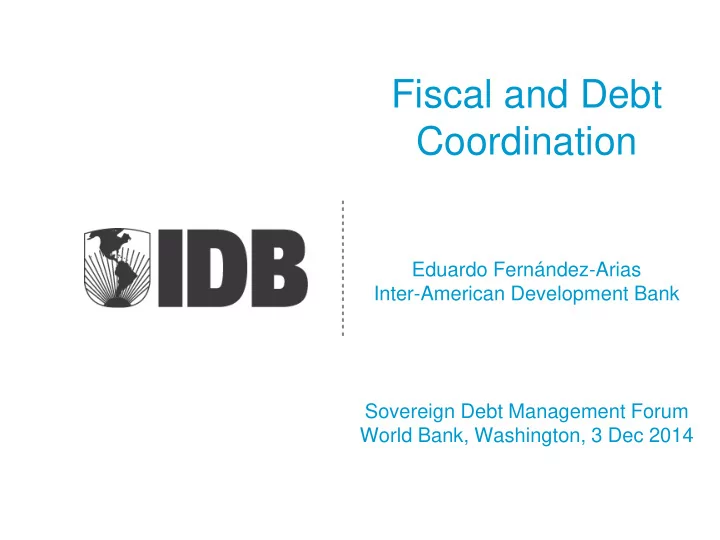

Fiscal and Debt Coordination Eduardo Fernández-Arias Inter-American Development Bank Sovereign Debt Management Forum World Bank, Washington, 3 Dec 2014
Outline 1) The Macroeconomic Space – Fiscal policy as a macroeconomic tool 2) Fiscal policy needs suitable debt management 3) The Fiscal Space – Long-term debt sustainability 4) The Financial Space – Liquidity risks
1) The Macroeconomic Space Fiscal policy as a macroeconomic tool
Fiscal policy is key to inclusive economic development… Public spending on infrastructure. High growth benefits: Health High development value of social policies Education Etc…
…and macroeconomic stabilization over the economic cycle • Low resource cost of public spending when resources are underemployed • Potential aggregate demand effects of such spending (non-traded intensive, “crowding - in” of public investment) • Stabilization of the financial system • High benefits to social spending in economic downturns
Ideally, fiscal spending (G) would be appropriately strong and countercyclical • Fiscal balance contaminated by temporary revenues B = R – G = (SR+TR) - G • Fiscal stance better gauged by the structural balance SB = SR – G = B – TR, so that G = SR - SB • Acyclical fiscal policy produces SB delinked from TR • In countercyclical policy, SB higher when TR smaller
2) Fiscal policy needs suitable debt management
Fiscal and debt policies are interlinked • Strong fiscal policies usually need high debt carrying capacity to support investments • Countercyclical policies need ample borrowing headroom to accommodate downturns and shocks • Gross public financing requirements (debt roll-over plus fiscal balance) require reliable liquidity access. • Costs of public debt stocks are fiscal spending.
Fiscal and debt policies need coordination • The path of fiscal policy needs to stay within the limits imposed by prudent debt management. • Debt management policy needs to provide the best environment for the conduct of fiscal policy. • Debt managers and fiscal policymakers need to jointly assess areas of financial risks … • … and coordinate their policies and strategies to make them compatible
3) The Fiscal Space Long-term Debt Sustainability
Unsustainable fiscal policy is eventually weak and procyclical Fiscal adjustment, Unsustainable including cuts fiscal paths lead to costly fixes usually in downturns… Debt restructuring …or outright destructive macro -financial crises. Countries in unsustainable paths need a strategy to regain sustainability and may lack “fiscal space” for the “ macroeconomically right” fiscal policy
Fiscal Space and Debt Sustainability (1) • Debt sustainability (stable D/GDP in the long- term) requires that, on average, it is expected that the primary fiscal balance does not exceed the interest on rolling over structural debt net of growth: pb*= d(r-g) • Structural debt d is computed with foreign debt at equilibrium real exchange rate • All variables as fractions of structural or trend GDP
Fiscal Space and Debt Sustainability (2) • Taking current primary structural balance (PSB) as the expected average primary balance under the status quo, an indicator of fiscal tightness is the required adjustment pb*-PSB • High debt level shrinks fiscal space (high pb*), including indirectly through high financial cost (r) • High debt level would also make adjustment more urgent, before debt reaches ceiling (See Fernández-Arias and Pérez 2014)
Almost all countries in LAC had less fiscal space after emerging from Great Recession 2010 Fiscal Readiness Relative to 2007 Chile Costa Rica Panama Dominican Republic Ecuador Colombia Peru Lower El Salvador Paraguay Mexico Bahamas Venezuela Belize Nicaragua Brazil Uruguay Higher Argentina Bolivia
Degree of Readiness in 2010 under various scenarios Scenario Optimistic Central Pessimistic Costa Rica Panama Colombia Costa Rica Bahamas Bahamas Ecuador Lower Bahamas Colombia Chile Brazil Panama Dominican Republic Mexico Mexico Peru Brazil Mexico Peru Brazil Paraguay Uruguay Dominican Republic Intermediate Ecuador Venezuela Uruguay El Salvador Uruguay Venezuela Venezuela Peru Chile Belize Belize Paraguay Belize Colombia Dominican Republic Costa Rica Argentina El Salvador Higher Paraguay Argentina Argentina Ecuador Nicaragua Nicaragua El Salvador Bolivia Bolivia Nicaragua Chile Bolivia Panama
4) The Financing Space Liquidity Risks
Financial space: Is the financing needed to implement the right policy actually available? • Above ignored episodes of high global cost of borrowing (low liquidity) and vulnerability to sudden stops (liquidity risk). • A number of implications for debt management: – Watch volume of short-term maturities – Have a strategy for accessing liquid assets/reserves kept for a “rainy day” – Keep tabs on rollover risk through pre-contracting debt or lines of credit – Maintain fluid access to multilaterals, ILOLR
Role of multilateral institutions • Support right fiscal policy (in downturns, stimulus and/or adjustment depending on fiscal space) • Do so providing liquidity to supplement costly and precarious market funding available
Recommend
More recommend